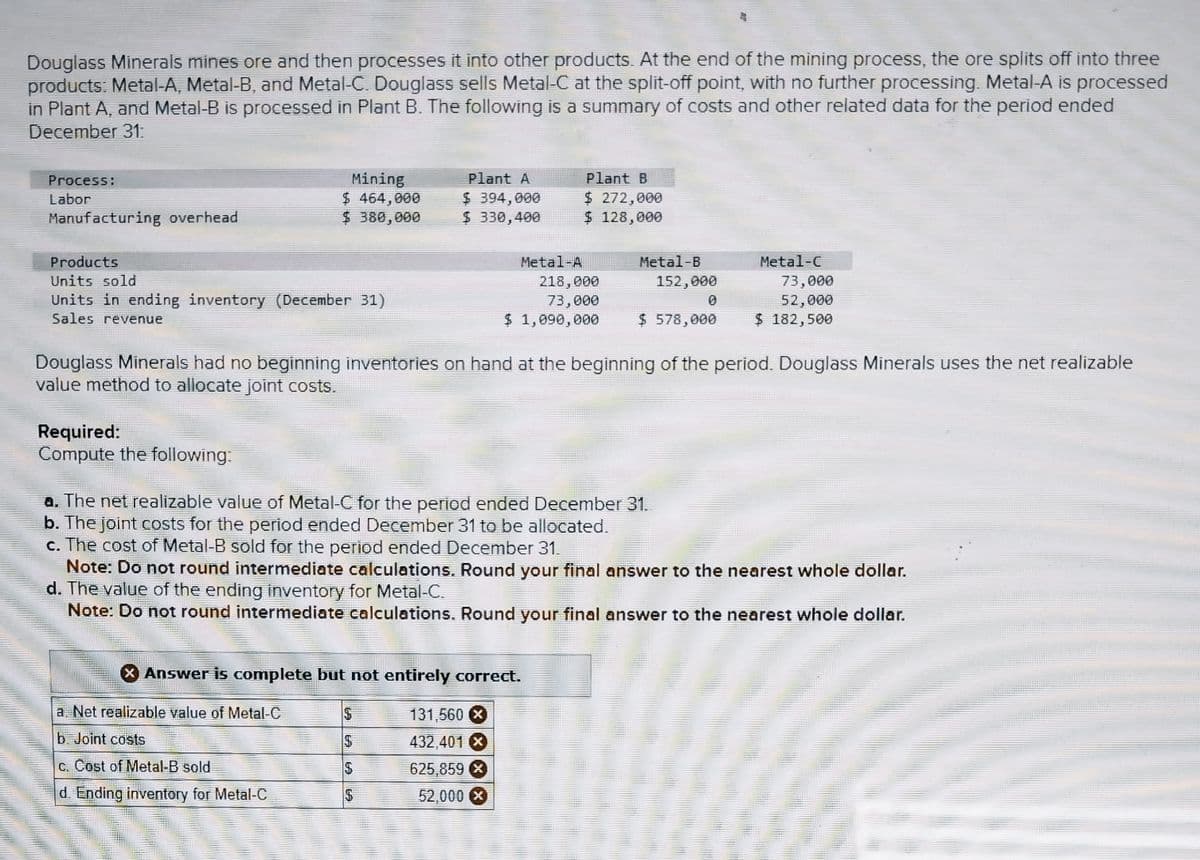Douglass Minerals mines ore and then processes it into other products. At the end of the mining process, the ore splits off into three products: Metal-A, Metal-B, and Metal-C. Douglass sells Metal-C at the split-off point, with no further processing. Metal-A is processed in Plant A, and Metal-B is processed in Plant B. The following is a summary of costs and other related data for the period ended December 31: Process: Labor Manufacturing overhead Mining $ 464,000 $ 380,000 Products Units sold Units in ending inventory (December 31) Sales revenue Required: Compute the following: Plant A $ 394,000 $ 330,400 Plant B $ 272,000 $ 128,000 Metal-A 218,000 73,000 $ 1,090,000 Metal-B 152,000 Metal-C 73,000 52,000 $ 578,000 $ 182,500 0 Douglass Minerals had no beginning inventories on hand at the beginning of the period. Douglass Minerals uses the net realizable value method to allocate joint costs. a. The net realizable value of Metal-C for the period ended December 31. b. The joint costs for the period ended December 31 to be allocated. c. The cost of Metal-B sold for the period ended December 31. Note: Do not round intermediate calculations. Round your final answer to the nearest whole dollar. d. The value of the ending inventory for Metal-C. Note: Do not round intermediate calculations. Round your final answer to the nearest whole dollar.
Douglass Minerals mines ore and then processes it into other products. At the end of the mining process, the ore splits off into three products: Metal-A, Metal-B, and Metal-C. Douglass sells Metal-C at the split-off point, with no further processing. Metal-A is processed in Plant A, and Metal-B is processed in Plant B. The following is a summary of costs and other related data for the period ended December 31: Process: Labor Manufacturing overhead Mining $ 464,000 $ 380,000 Products Units sold Units in ending inventory (December 31) Sales revenue Required: Compute the following: Plant A $ 394,000 $ 330,400 Plant B $ 272,000 $ 128,000 Metal-A 218,000 73,000 $ 1,090,000 Metal-B 152,000 Metal-C 73,000 52,000 $ 578,000 $ 182,500 0 Douglass Minerals had no beginning inventories on hand at the beginning of the period. Douglass Minerals uses the net realizable value method to allocate joint costs. a. The net realizable value of Metal-C for the period ended December 31. b. The joint costs for the period ended December 31 to be allocated. c. The cost of Metal-B sold for the period ended December 31. Note: Do not round intermediate calculations. Round your final answer to the nearest whole dollar. d. The value of the ending inventory for Metal-C. Note: Do not round intermediate calculations. Round your final answer to the nearest whole dollar.
Principles of Cost Accounting
17th Edition
ISBN:9781305087408
Author:Edward J. Vanderbeck, Maria R. Mitchell
Publisher:Edward J. Vanderbeck, Maria R. Mitchell
Chapter6: Process Cost Accounting—additional Procedures; Accounting For Joint Products And By-products
Section: Chapter Questions
Problem 1MC: Clark Kent Inc. buys crypton for $.80 a gallon. At the end of processing in Dept. 1, crypton splits...
Related questions
Question
Sh19

Transcribed Image Text:Douglass Minerals mines ore and then processes it into other products. At the end of the mining process, the ore splits off into three
products: Metal-A, Metal-B, and Metal-C. Douglass sells Metal-C at the split-off point, with no further processing. Metal-A is processed
in Plant A, and Metal-B is processed in Plant B. The following is a summary of costs and other related data for the period ended
December 31:
Process:
Labor
Manufacturing overhead
Products
Units sold
Units in ending inventory (December 31)
Sales revenue
Mining
$ 464,000
$ 380,000
Required:
Compute the following:
a. Net realizable value of Metal-C
b. Joint costs
c. Cost of Metal-B sold
d. Ending inventory for Metal-C
Plant A
$ 394,000
$ 330,400
Answer is complete but not entirely correct.
131,560 x
432,401 X
625,859 X
52,000
$
$
Plant B
$ 272,000
$ 128,000
Metal-A
218,000
73,000
$ 1,090,000
$
$
Douglass Minerals had no beginning inventories on hand at the beginning of the period. Douglass Minerals uses the net realizable
value method to allocate joint costs.
Metal-B
152,000
a. The net realizable value of Metal-C for the period ended December 31.
b. The joint costs for the period ended December 31 to be allocated.
c. The cost of Metal-B sold for the period ended December 31.
Note: Do not round intermediate calculations. Round your final answer to the nearest whole dollar.
d. The value of the ending inventory for Metal-C.
Note: Do not round intermediate calculations. Round your final answer to the nearest whole dollar.
Metal-C
73,000
52,000
$ 578,000 $ 182,500
0
Expert Solution
This question has been solved!
Explore an expertly crafted, step-by-step solution for a thorough understanding of key concepts.
Step by step
Solved in 2 steps

Knowledge Booster
Learn more about
Need a deep-dive on the concept behind this application? Look no further. Learn more about this topic, accounting and related others by exploring similar questions and additional content below.Recommended textbooks for you

Principles of Cost Accounting
Accounting
ISBN:
9781305087408
Author:
Edward J. Vanderbeck, Maria R. Mitchell
Publisher:
Cengage Learning

Principles of Accounting Volume 2
Accounting
ISBN:
9781947172609
Author:
OpenStax
Publisher:
OpenStax College

Financial And Managerial Accounting
Accounting
ISBN:
9781337902663
Author:
WARREN, Carl S.
Publisher:
Cengage Learning,

Principles of Cost Accounting
Accounting
ISBN:
9781305087408
Author:
Edward J. Vanderbeck, Maria R. Mitchell
Publisher:
Cengage Learning

Principles of Accounting Volume 2
Accounting
ISBN:
9781947172609
Author:
OpenStax
Publisher:
OpenStax College

Financial And Managerial Accounting
Accounting
ISBN:
9781337902663
Author:
WARREN, Carl S.
Publisher:
Cengage Learning,

Managerial Accounting
Accounting
ISBN:
9781337912020
Author:
Carl Warren, Ph.d. Cma William B. Tayler
Publisher:
South-Western College Pub